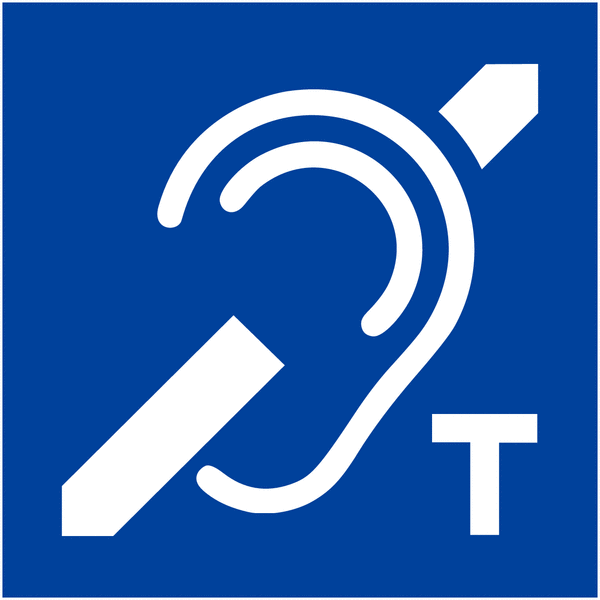A basic loop system is quite simple to put together. In fact it is rather like a standard sound system but with the loudspeaker replaced by the induction loop.
Sometimes a public address or sound system may already be installed, or perhaps a more sophisticated arrangement may be planned with inputs from various sources.
Where a satisfactory sound system is already installed the loop amplifier can be fed from the mixer or pre-amplifier stage of the system. This will save on duplication of microphones if these have been well chosen and sited in the first place but still give independent control of signal from the loop.
In the absence of an existing sound system it will be necessary to provide microphones and inputs to the loop amplifier for any other signals. When microphones are to be used it is vital that they are positioned to pick up sound, which is free from reverberation and other noises. If the microphones receive a poor signal then the signal transmitted to the listener will be poor no matter how good the design of the loop and other equipment. It is also necessary to ensure that the microphones are matched electrically to the amplifier so that it is 'driven' adequately when the loop is in operation.
When positioning microphones in rooms, the microphones should be as close to the person speaking as is practicable, for example in a classroom if the microphone is placed in the ceiling in the room centre, the loop microphone will be further away from the speaker than the microphone in the hearing aid of someone sitting on the front row of the class!
All loop installations in the UK should conform to the Code of practice BS7594, this gives advice on the minimum areas to be covered, positioning of microphones and commissioning the system.
It is important to consider the loop itself as forming an integral part of a sound system. A British Standard Code of Practice for the 'Planning and Installation of Sound Systems' BS 6259: 1982 gives valuable information to engineers on various design aspects of such systems.
Before installing any loop system a survey should be undertaken to determine the construction of the building, and the location the loop cables can be placed in, certain materials, such as raised steel deck flooring or aluminium ceiling tiles will prevent the loop from being placed above or below these items, if you are in any doubt always lay a test loop before proceeding with the installation.
We supply and install a comprehensive range of induction loop, infra-red and FM radio systems. If you don't see what you need, or would like more information, please contact us.
Induction loop supply and installation
It is important that you 'The Customer' fully understand the technical limits and problems the Audio Frequency Induction Loop System technology can cause. It is therefore important that the following terms and conditions set out are adhered to:
Optimal Information
It is essential that you 'The Customer' inform us of the activities that will take place in the specified room where the loop system will be installed and also the activities that may take place in adjacent rooms (as this may affect the loop system).
Magnetic Background Noise Interference
All electrical appliances and installations generate some form of magnetic field. If the field that is generated is strong enough it may cause the hearing aid user to experience some interference, which will render the loop system ineffective. In the event that the Ambient Magnetic Interference is found to be greater than 20dB we will advise that the installation will not go ahead, for which you will be charged accordingly.
Magnetic Overspill
It should be noted that by installing a loop system we are creating a magnetic field. It is possible that this magnetic field can overspill or cause interference into other rooms both next to, adjacent to, above or below the room that the loop system is installed in. This may give cause for concern in the following areas:
Magnetic Soak Up
With this particular type of technology, the sound quality of a loop system can be influenced by metal work. For example: reinforced concrete, suspended ceiling grids, steel frame construction, and air conditioning metal ducts etc. If we are unable to carry out a survey of soak up during pre installation and we discover the magnetic soak up restricts the magnetic field strength to below +6dB + 3dB we shall advise that the installation should not go ahead and you will be charged accordingly.
Further Options
In the event of a non compliance with the above there are further options that can be considered. These options consist of FM systems or 'Infra-Red' system.
Survey and Measurement Check Disclaimer
Should you 'The Customer' not adhere to the terms and conditions that are set out, leading to the absence of being able to carry out the above test, we cannot be held responsible for the final outcome.
Acceptance of an Estimate
Should you go ahead and accept the estimate, an official order is required. Verbal orders are not acceptable.
VAT Note
The proposed works are solely for those who have a hearing disability and wear a hearing aid with the T switch facility. The VAT element can therefore be zero rated providing that the purchaser is a registered charity and completes a declaration form as supplied by us.
